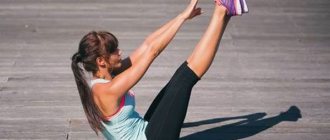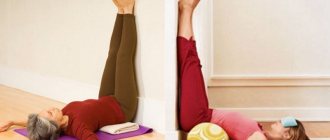Almost every person who watches their figure dreams of having beautiful, dense abdominal muscles. In people prone to excess weight, they are not visible, but are present on the abdomen (maximum 8 muscle fragments).
If you correctly perform the lying leg raise exercise, it is possible to work the lower half of the abs, which uses the entire length of the muscles.
The most accessible exercise at home would be leg raising, since this does not require any additional equipment.
This exercise is necessary for the following reasons:
- is a simple morning exercise accessible to everyone;
- has a positive effect on the abdominal muscles, strengthening their lower part;
- even a physically undeveloped person can easily perform exercises;
- affects the body as a whole, preventing the occurrence of osteochondrosis and intervertebral hernia;
- rehabilitates muscles after surgical interventions in the abdominal cavity.
How to perform the leg lift exercise correctly?
The photo of the lying leg raise shows possible options for its execution:
For beginner, unprepared athletes, it is recommended to lift the legs one by one while lying on your back: - you need to lie on your back, pressing your lower back tightly to the floor, with your hands behind your head, or stretch them along your body. The legs should be brought together.
Then you need to hold one leg for 2 seconds, raising it at an angle of 40-60 degrees. Next, return it to the starting position. Do a similar movement with the other leg. You need to know that for beginners, for less stress on the muscles, you can slightly raise your head.
A person who has good health and an average level of preparation for physical activity should perform simultaneous leg lifts without load:
Just as with the first option, you need to lie on your back with your legs together. But you need to raise both legs at once by 45-60 degrees, pause for 2 seconds and return to the starting position.
At the same time, if you lower only your heels to the floor, the exercise will be simplified, and if you do not bring them to the floor, it will be much more effective in influencing the abdominal muscles and keeping them in the maximum position.
Do the exercise 12 times in 2 or 3 repetitions. If your health and well-being are excellent, you can keep your legs in the air for more than 2 seconds.
With already developed abdominal muscles, increasing the load will be required for greater efficiency. Therefore, it is recommended to perform leg lifts while lying on the press with weights.
The initial position is similar to the first two, only a weighting agent is attached to the legs or you can hold a dumbbell with a certain individual weight with your feet. The legs brought together must be lifted and held in the air in the same way.
To keep your abs strong and increase the volume of your abs, you need to use different training tactics. If you perform each given exercise with the maximum possible number of repetitions and at the highest speed, the limits of abdominal endurance are greatly expanded until a burning sensation appears in the lower abdomen.
But to maintain muscle tone and a beautiful figure, you just need to do daily exercises of 10 repetitions in 2 sets.
To create pumped up, more defined abs, you need to combine several muscle exercises at once, increase the number of approaches and repetitions. And also use maximum weights in combination with proper technique. It is important to gradually increase the load on the body to avoid harm to health.
Hanging Knee Raise
Grab the bar and hang on it:
- inhale and pull your knees as high as possible, trying to bring them closer to your chest by twisting your body, then return to the starting position;
- At the end of the movement, exhale.
This exercise uses:
- iliopsoas, sincere muscles of the thighs, tensor fasciae extensivea when climbing the legs;
- sincere abdominal muscles and at least the oblique muscles, sometimes you pull your knees to your chest. For the most isolated exercise of the abdominal muscles, do not lower your knees more than horizontal.
Abdominal-lumbar ratio
It is extremely important to measure the muscles of both the abdominals and the back, which straighten the spine. Lack of the necessary tension or excessive tension in one of these muscle groups can lead to an erroneous body position, which in the future can lead to a variety of pathologies.
Example:
Excessive tension in the back muscles that straighten the spine (sacrolumbar muscle mass), coupled with insufficient tension in the abdominal muscles, increases the curvature of the spine (anterior bending) and immediately prolapse of the internal organs of the tummy. From time to time, this deficiency, if it is not advanced, can be corrected with special exercises that strengthen the abdominal muscles.
On the contrary, excessive tension of the abdominal muscles, coupled with weakness of the spinal muscles that straighten the spine, especially in their higher parts (spinalis dorsi, longus dorsi, iliocostal dorsi), causes kyphosis of the thoracic spine and loss of lumbar curve. This deficiency can be corrected with special exercises that strengthen the muscles that straighten the spine.
Performance
- Grab the bar with a straight, medium grip and hang from it. Legs are down. This is the starting position.
- As you exhale, bending your knees, raise your hips as high as possible, trying to touch your chest.
- Slowly return to the starting position along the same path.
To put more stress on the lower abdominal muscles, keep your legs slightly bent at the knees in the lower position, and while raising your hips, try to lift your pelvis.
This exercise can be performed with straight legs. This way you will put maximum stress on the lower abdominal muscles. The exercise is performed on a special machine with a back support.
If you have difficulty supporting your own weight on the bar, then use special elbow support sleeves.
Hanging knee raise technique
Recommendations for implementation:
Raise your legs as high as possible. In the first phase of the exercise, the load mainly falls on the hip flexor muscles. The lower part of the press begins to contract from an angle of 30-45 degrees. The more you bend your knees, the lower the load on your abs and vice versa
Use this to adjust the intensity of your training. Please note that with strong quadriceps and good stretching, you need to raise your legs much higher while hanging.
Popular rules for abdominal exercises
For greater efficiency and safety, you must follow some simple rules:
- you cannot lift your body off the floor at the same time as your legs, that is, your back should be pressed tightly to the floor;
- When performing exercises, be sure to have a soft polymer mat on the floor so as not to harm your health;
- exercises must be performed correctly, that is, smoothly and without wasting excess strength;
- when you raise your legs, you must hold them on top for a few seconds;
- strain your abdominal muscles while smoothly lowering your legs to the starting position without jerking;
- no pain should be allowed; it is better to reduce the load on the back;
- legs should not be bent at the knees;
- It is worth doing physical exercise an hour after eating, and after that it is recommended not to eat for 2 hours.
A fairly effective exercise is lifting your legs while lying on your stomach:
You need to lie on your stomach, bend your elbows and place them near your chin. Next, you need to pull in your stomach as much as possible, maintaining tension in your lower back, and place your straight legs shoulder-width apart. Then raise your legs up and lower them until your hips touch the floor again.
Improves appearance
By regularly doing this exercise, you can improve the condition of your skin and hair, slow down the appearance of gray hair, and even tighten your facial muscles. Doctors explain the anti-aging effect by improving blood flow in the upper parts of the body, improving metabolism in the body and the calming effect of this position.
Interesting fact!
The “legs up” position gained its popularity after the massive spread of yoga, where it was known as “Viparita Karani”. In Sanskrit it means "upside down, but in action." According to Eastern teachings, this pose bestows youth by directing all vertical flows in the opposite direction. This is a completely natural state for our body. Remember that a healthy baby spends almost all of his time lying down, and if he is not swaddled, you can notice how he lifts his legs up.
Lying leg raise photo
(3
ratings, average:
5.00
out of 5)
The technique of performing leg raises is simple, so you can master it from the first lesson if you know how to do it correctly. There are several options. Each has its own degree of effectiveness. You need to choose yours based on your current physical condition and the purpose of doing the exercises.
If you just need to get rid of a couple of centimeters, then doing these exercises will quickly achieve your goal. When you need to adjust larger volumes, it is important to reconsider your diet, including through a proper diet.
Purpose of the exercise
Performing leg raises while lying on the floor is an easier version of hanging leg raises.
The exercise can be easily done at home. This does not require any additional devices. Therefore, it is a universal remedy for maintaining abdominal muscle tone in any circumstances. What are lying leg raises used for:
- To strengthen the abdominal muscles, especially the lower part, at any level of physical fitness.
- To increase abdominal strength and endurance.
- Exercise has a therapeutic effect on the body. In particular, it is used as an element in the prevention of osteochondrosis and intervertebral hernias, and is also suitable for rehabilitation after abdominal surgery on the peritoneum.
- As an element of morning exercises for children and adults.
Lying on your back: 3 types of exercises
The correct choice of option depends on the level of training of the person:
- Weak abs (needs to be strengthened).
- Good physical shape of the body (you just need to give your abs some relief).
- Athletic shape of the torso, healthy body. Lifts should be performed in order to increase the level of the current load.
Leg Raises: Basic Level
IP: lie on your back. Your arms should be extended along your body.
- Raise your head. Keep your legs together. Raise at an angle of 45°. After a couple of seconds, return to IP.
- When your heel touches the floor, lift your other leg.
- Perform for the other leg.
- Exhale when the body receives a strong load. Exhale and raise your legs, and while inhaling, lower them.
Without burden
IP: lie on your back. The head should not be raised (this relieves stress). The legs are placed together.
- Raise both legs to a 45° angle.
- Hold them up for a couple of seconds. Lower it back down.
- The heels lie on the floor. For an advanced level: the heels should not be lowered to the floor under any circumstances. Leave them at a distance of 2 cm from the floor (all this time the abs are tense).
- For greater load, spread your legs to the sides as in the photo. Do 10 reps.
- At first (the first week) you should lower your feet to the floor.
- After a couple of weeks, make the exercise more difficult and prevent your heels from touching the floor.
- Hold your legs for two or more seconds.
Lying down with weights
IP: lie on your back, legs together.
- A weight should be attached to each leg.
- Hold dumbbells with your feet. The weight should be chosen small (it’s better to start with 0.5-1 kg and, when this weight is barely noticeable, increase the load).
- Lifting on an incline bench with dumbbells at your feet must be done carefully. It is better under the supervision of a coach or experienced mentor.
- Raise your legs at an angle of 60° (no more).
How to develop abdominal strength, pump up your six-pack and increase endurance
It should be understood that it is impossible to pump up both at once. To achieve each goal, the tactics will be different.
Strength and volume
Note that when performing abdominal exercises, in particular, lying leg raises, volume and strength can be increased by following the following rules:
- The number of approaches is 3-4.
- Reps in each approach are 10-12.
- We use maximum weights (those when you can do 10-12 repetitions with the correct technique, no more).
- Adding loads. Do you feel like you can do more without your technique suffering? Let's increase it. Gradually, there is no need to rush!
Endurance
Everything is much simpler here. We do the maximum possible number of repetitions in a prone position in an accelerated version. Two approaches are quite enough to expand the limits of abdominal endurance. We work through the burning sensation in the muscles.
We suggest that you familiarize yourself with Raising the pelvis in a lying position
On the stomach
A useful exercise that actively engages the buttocks. IP: lying on your stomach, you need to bend your elbows.
- Draw your stomach in, maintain tension in the lumbar region and do not allow it to bend.
- Legs straight. Keep them shoulder-width apart, raised up.
- Lower down until your hips touch the floor.
- When contact occurs, lift them up.
- Use a bench or step as a height (the pelvis rests in the corner). This will increase the amplitude and allow you to work the gluteal muscles.
The back should not be rounded, otherwise the lower back will receive unnecessary and harmful stress. You need to put a support under the pelvis, this will increase the amplitude.
Errors:
- Place your feet on the floor and relax.
- Raise the body with your hands.
Execution Features
There are several ways to perform hanging leg raises. They all differ in complexity and technique. Only trained athletes can perform the classic variation of hanging leg raises to the bar. For beginners, hanging knee raises or standing leg raises are more suitable.
To perform the “Hanging Leg Raise” exercise for the press, you only need to have at hand only a horizontal bar or crossbar of a suitable height. By the way, there is probably a horizontal bar in any gym or yard sports ground. Thanks to this, this exercise is accessible to almost everyone and is very popular among athletes. For convenience, you can buy a horizontal bar for the doorway and perform hanging leg raises even at home at any suitable time.
Using the “Hanging Leg Raise” abdominal exercise, you can perfectly pump up not only the rectus abdominis, but also the external oblique abdominal muscle. In addition, if you want to specifically pump up your lateral abs, I advise you to do hanging leg raises or hanging knee raises with knees rotated to the sides at the top of the range of motion.
Muscles involved
Many beginners are interested in which muscles work when they do hanging leg raises on the horizontal bar. First of all, like all exercises for training the abdominal muscles, hanging leg raises directly engage the abdominal muscles. Namely, the rectus abdominis and external oblique muscles. In addition, at the beginning of the movement, until the moment when you raise your legs 30-45 degrees, the leg muscles also work hard. First of all, these are the long adductor and rectus femoris muscles.
Then the entire load goes directly to the abdominal muscles. At that time, the forearms receive an indirect static load. Therefore, if you want to not only pump up your abs, but also strengthen your forearms and hands, then instead of the usual abdominal crunches, do hanging leg raises on the horizontal bar.
Execution technique
The technique of performing leg raises while hanging on a bar is very simple. First of all, you need to take the starting position - hanging on the bar with a straight grip slightly wider than shoulder width. Now you can start doing this exercise for the abdominal muscles. To do this, you need to use the force of the target muscles to raise your legs, slightly bent at the knees, to the level of the crossbar or at least above parallel with the floor. After going through the most difficult part of the range of motion, exhale.
Then, keeping tension in your abdominal muscles, lower your legs down while inhaling. The main task is to prevent the body from swaying while hanging on the horizontal bar and to raise not only your legs, but also lift your pelvis up, while rounding your back, as when doing abdominal crunches. This is the only way to pump up your abdominal muscles as effectively as possible.
Recommendations and common mistakes
- When performing the Hanging Leg Raise abdominal exercise, do not swing your legs back and forth to avoid inertia and dissipate the load throughout your body. Remember, if you want to pump up your abdominal muscles, you need to concentrate on working the target muscles, that is, the abdominal muscles.
- The height of the crossbar or horizontal bar should be such that your feet lightly touch or do not touch the floor at all.
- To increase the load on your abdominal muscles, try to keep your legs together during the exercise.
- At the top phase of the movement, try to lift your pelvis up, as when doing a crunch. Only in this position does contraction and development of the abdominal muscles occur most effectively.
- When performing hanging leg raises to the bar, do not try to do pull-ups or bend your elbows. Your arms should remain straight throughout the entire approach. You can move your pelvis forward slightly so that your abdominal muscles maintain constant tension.
- To get six-pack abs, perform hanging leg raises twice a week at the end of your workout. Do 3-4 sets until failure occurs due to a hellish burning sensation in the abdominal muscles.
- Leg raises while hanging on the bar are complex abdominal exercises that can be performed by trained athletes with strong core muscles. Therefore, as a rule, leg lifts are performed without additional weights. However, if you were able to easily complete 3-4 sets of 20 repetitions, then you can use special leg weights as additional weight. This will allow you to further increase the workload on your abdominal muscles.
- If you have a weak grip, use special wrist straps or perform leg raises on a machine.
The nuances and benefits of lifting legs from a supine position
Muscle work
The key criteria that distinguish this load from others are:
- Frame. You need to keep your body up. This creates the desired load, paying special attention to the rectus muscle.
- Hands. When the palms are placed under, they lift the pelvis. This creates an optimal slope.
- Hips. Thanks to the pelvis, which is slightly raised, you can press the belt to the floor, protecting yourself from possible injuries.
- Bench angle. The lower the bench is, the greater the level of load placed on the abs. You can complicate the task - from a lying position on a bench, keep your legs hanging.
- You need to lie on your back. The lower back is pressed to the floor. Feet require special attention. They need to be pulled and then straightened. Your heels should touch the floor and bend your knees slightly.
- Exercise is useful after surgery.
You can't relax. Pay attention to where your lower back is. She is pressed down, this is necessary to keep her safe.
How many times a week should you exercise
As an exercise, 1-2 sets of 10 repetitions can be done daily in the morning. Without weights, start by raising your legs one at a time. Depending on how you feel, switch to simultaneous lifting. Do not use weights.
To develop strength and abs, 2 times a week is enough. Remember, this is just one of several exercises, so you need to do other exercises to achieve this goal.
To develop endurance, you can train every day. Moreover, do the maximum number of repetitions 2 times a week. On other days - 2-3 sets of 30 times. For beginners, just 2-3 times a week is enough. Believe me, the effect will be noticeable.
Causes of injury
The Gorinevsky symptom can develop out of the blue. A fall from your own height is enough to injure the femoral neck.
This disorder is typical for people:
The whole danger of a fracture in the femoral neck is that there is a high probability of non-union of the bone.
Variations
In addition to the typical exercise, there are several variations. Each type of training is designed for people with different sports backgrounds (beginners, professional athletes and people undergoing rehabilitation measures):
1. Alternating leg raises for beginners.
Lie down on a gymnastics mat. Straighten your back and legs. You can place your hands under the lower back or behind your head, clasping them together.
Movements: exhaling, raise one leg up to 45-60 degrees. Hold for 2 seconds. Lower your leg completely, touching the heel to the surface. As soon as the lower limb has taken the starting position, raise the opposite leg to the same angle. It is allowed to raise your head during the first few workouts, this will lighten the load a little.
2. Restorative exercise during the rehabilitation period (after surgery of the abdominal cavity, pelvic area, etc.). Lie down on the mat and completely relax. Straighten your back. Place the cushion under your head in the neck area. Keep your arms along your body. Your legs can be slightly bent at the knee. As you exhale, lift one leg, reaching an angle of 90 degrees. Hold for 2 seconds. As you inhale, return to the starting position. Repeat the same with the other limb. At the top point, try to gradually straighten your knee.
Before performing this exercise, you should consult a specialist. The doctor will prescribe the required load. Independent training is strictly prohibited. Leg lifts are contraindicated for pregnant women, since the main load falls on the lower abdomen, and an overly toned abs makes labor difficult.
3. Simultaneously raise your legs to an angle of 45-60 degrees.
This exercise option is suitable for athletes with average physical fitness.
The initial position is identical to the classic version, i.e. horizontally. Raise your legs simultaneously to an angle of 45 or 60 degrees. At the end point, fixate for 2-3 seconds. As you inhale, return to the starting position without your heels touching the surface, maintaining a distance of 2-3 centimeters.
To simplify the exercise, full contact of the legs with the surface is allowed. This way the abs will rest, but this makes the workout less effective.
4. Weighted leg raises.
If your abdominal muscles are developed and there is a need to increase the load, this variation is just for you. The technique is similar to the classical one. Only here it is necessary to attach a weighting agent to each lower limb or hold the dumbbell with your ankles. The weight of the weighting agent is selected for each athlete individually. Raising the legs is carried out to an angle of 45 or 60 degrees. Do not touch the floor with your feet, but leave a distance of 3-4 centimeters. Perform the required number of approaches and repetitions.
5. Lying on your stomach.
Starting position: lie on your stomach. Stretch your arms forward. Close your legs together. As you exhale, alternately lift your lower limbs up. Try to fix your hips as much as possible. They are not allowed to be torn off the floor.
6. Leg raises while lying on your side.
Lie on your side. Bend your arm at the elbow and rest on it. Legs straight. Technique: while exhaling, raise the lower limb as high as possible. Make sure that your leg does not bend at the knee joint. Perform the required number of times and change the position of your body, turning over to the other side.
Each leg lift option can be performed on training equipment or on a regular flat bench. The training does not require additional equipment, so it can easily be done at home.
Treatment
Treatment for such a complex fracture is long and painful. Young patients are often given an immobilizing hip bandage for 3 months. Only after this is it allowed to try to walk on crutches. You can load the bone no earlier than six months after the fracture occurs. And full recovery will occur no earlier than in 8 months.
It is much more difficult with elderly patients. They are prescribed skeletal traction for a period of 2-2.5 months. Then a light course of exercise therapy in a lying position. Only after 2 months are they allowed to try to walk on crutches without putting weight on their leg.
A hip fracture, one of the symptoms of which is the so-called “stuck heel,” is a fairly serious injury. Long, painful treatment may require not only conservative measures, but also surgical intervention. Often this injury is a consequence of a chronically progressive metabolic disorder of the human bone skeleton.
The human abdominal press has pronounced fragmentation. Achieving the appearance of relief is not easy work. “Cubes” are developed through training aimed at the lower abs. Lying leg raises will help us make the lower abdominal region work.
The leg raise exercise focuses on pumping the lower muscle segment. Develops the muscles of the abdominal region, hip flexors, develops the hip joint. The process involves stabilizers and back muscles - this is the prevention of diseases of the musculoskeletal system.
Performing the exercise “lifting legs while lying down” does not require special training or equipment - it is performed in the gym, at home, constantly maintaining physical shape. It is important to maintain the correct technique without harming the body.
Reduces back pain
The leg-raising pose can be considered as an option for inversion therapy. This is a recognized method of treating and preventing spinal diseases according to the recommendations of the American College of Physicians. In classical inversion therapy, your body is inverted so that your heart is higher than your head. The essence of the therapy is to temporarily relieve the spine of the heaviness it experiences due to gravity. But you don't have to hang upside down. It is enough to raise your legs and lie on a smooth surface without placing a pillow under your head.
Even in this “light” version, the spine is stretched and pressure on the discs and roots of the spinal cord is reduced. After 15 minutes of staying in this position, you will feel that your back pain has decreased significantly. By regularly performing this exercise, you can even relieve the symptoms of sciatica and scoliosis and reduce the likelihood of surgery. In this position, the muscles that straighten the spine, which are in a state of spasm due to pain, relax. The back becomes more flexible, so the risk of compression of the nerve roots and a new attack of pain is significantly reduced.
Important!
Before performing the exercise, make sure that you do not have the following contraindications:
- high blood pressure;
- sinusitis;
- nasal congestion;
- glaucoma;
- conjunctivitis;
- risk of retinal detachment;
- spinal or neck injuries;
- otitis;
- umbilical or inguinal hernia.
Lying leg raises: technique for performing exercises for the lower abs
The body should be loaded gradually. Start with a slight variation of pumping the lower segment of the abdominal area, especially after undergoing surgical interventions in this location or childbirth. An easy variation for beginners is to lift your legs one at a time.
Alternating leg raises
- Lie on the floor, press your lower back tightly. The arms are extended along the body and placed under the head.
- Raise the straight lower limb, forming an acute angle, hold it, and lower it smoothly.
- Repeat the action with the second limb.
You should breathe correctly: at maximum tension (when your legs are raised above the floor), inhale; when lowering them to the mat, exhale.
If a person has undergone abdominal surgery, he is given a medical discharge. The attending physician allows you to attend classes. At the rehabilitation stage, it is easier to carry out the load with bent knees, the back of the head raised, and listen to the sensations: if discomfort appears in the surgical field, stop the action.
Raising both legs
A classic variation for working out the muscles of the lower abdominal segment is raising both legs from a lying position. Aimed at developing muscles and developing sculptural relief. Execution technology:
- Lie down on a flat surface, mat or rug. Connect your legs, press your lower back. In the complicated version, do not raise your head.
- Smoothly raise your legs at an acute angle, hold for a couple of moments, then lower smoothly.
- Repeat.
Beginners are allowed to place their heels on the mat while working: the body rests and strength is restored. It is more effective not to touch it with your feet, leaving a distance of several centimeters: the muscle tension will not be interrupted.
The number of repetitions starts with ten times, increasing to thirty, performing two or three approaches.
Weighted technique
For athletes and people with a decent level of physical fitness, the leg lift exercise is performed while lying on your back, with weights attached to the ankles.
The equipment is a small simulator that is worn on the limbs to enhance the productivity of the workout. The “weight” comes with a constant or adjustable weight.
Performance:
- Attach a weighting element to the ankles.
- From a horizontal position, raise your legs and hold them at an acute angle for several seconds.
- Lower your legs without touching the floor surface, maintaining a distance of two to three centimeters from it. Performed thirty times, two or three approaches.
With stable sports activities, the body gets used to the loads imposed, muscle mass ceases to feel the weight of the weighting agent, it must be increased.
Raising both legs while lying on the floor alone will not create relief in muscle mass; it is effective in combination with additional exercises on the abdominal area.
To develop fatigue and increase metabolism, the vertical leg raise exercise while lying on your back is performed at an accelerated pace with a maximum number of repetitions. The work is accompanied by a burning sensation in the affected location.
Training frequency
Lifting the legs while lying on your back is performed to harden the muscles, improve endurance, and form a pronounced relief.
You should start practicing gradually: with ten repetitions of raising your legs in turn. One or two approaches are enough for the beginner level. When the body gets used to kilograms of weights, the number of repetitions increases and the load is added.
To show relief, the norm is two sessions in seven days (in combination with other loads on the abdominal muscles). To improve overall muscle strength, exercise daily: two days loading the abs with a number of approaches, five days exercising to maintain tone.
Erroneous execution
Lifting your legs while lying down should be done efficiently.
What not to do:
- Tear off the body from the surface. The legs are involved in the work, the body should be pressed tightly to the floor. Violation threatens injury to the intervertebral discs.
- Exercise without bedding. No matter how hot it is during the process, a cold floor is the reason for a cold back to get cold. The rule includes a ban on being in rooms with air conditioning.
- Perform sudden throwing and lifting of legs while lying on the floor. Jerks lead to inertial contraction of the body muscles, unloading the desired area. Intense speed must be accompanied by leisurely action.
- If you don’t hold the moment at the highest point, the benefits of the training are reduced.
- Perform leg lifts while lying on your back, overcoming pain. If you feel discomfort, reduce the weight of the weights. If it doesn't work, stop executing. The presence of diseases of the gastrointestinal tract and musculoskeletal system requires early consultation with a specialist. When working with a trainer, warn him about the presence of ailments.
- Raising bent legs. This is acceptable at the initial stage of physical training. Correct execution - with straight legs.
- Workout with a full stomach. A hearty lunch is the reason for an unsuccessful visit to the fitness room, a feeling of heaviness, and nausea. Come to the hall in an hour.
The correct approach to training and adherence to execution technique will not harm the spine, organs and muscle tissue.
Well, that's all) Thank you all for reading our article. We also recommend reading the article on the topic - how to pump up your lower abs. It contains the TOP 9 coolest exercises for the lower abs. See you soon in new articles.
Reduces fat around the waist
It's hard to imagine that simply lying on your back with your legs stretched up will help you lose excess fat around your waist. But experts in the field of oriental medicine are convinced that fat accumulates where blood circulation is poor and toxins accumulate. Western evidence-based medicine confirms that with poor blood circulation, oxidative stress develops in the vessels. At the same time, harmful oxygen radicals destroy cells and maintain low-grade inflammation.
If your waist has increased due to internal fat in the abdominal cavity, when you raise your legs up, you disperse blood through the internal organs. This improves their function and restores mobility. As a result, metabolism improves and toxins are removed in time. The fat layer also receives its share of blood and stops releasing free radicals. Also, by helping the body fight obesity in the waist area, you significantly reduce the risk of developing type 2 diabetes.
Interesting fact!
If the fat layer does not receive enough blood, the body redistributes the blood flow so that there is enough for the fat cells, but because of this, other organs suffer. The more fat, the less organs receive blood, and the more substances are produced in the body that cause vasospasm and the production of oxygen radicals.










